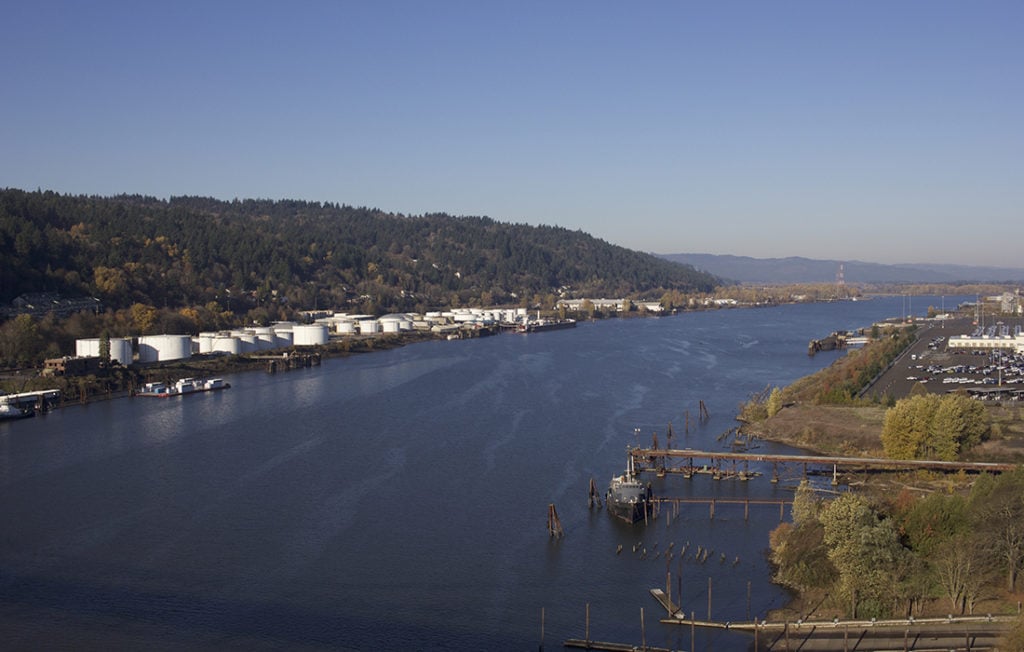Portland Harbor Superfund Site
The Superfund designation is reserved for the most contaminated and complicated sites in the country. A 2000+ acre, ten mile long area of the Willamette River extending from near the Broadway Bridge almost to the confluence with the Columbia River was designated as a Federal Superfund Site in 2000. (See a map of the Portland Harbor Superfund Site.)
The site is contaminated with 29 compounds that pose a risk to human health and 89 compounds that pose a risk to ecological health. These include PCBs, DDT, PAHs, lead, arsenic, mercury and heavy metals. More than 140 entities including businesses and public agencies such as the U.S. Military, Port of Portland and City of Portland have been identified as responsible for this pollution. The contamination presents a real risk to people, especially those who eat resident fish from the river, fish and wildlife populations on this stretch of river and our economy.

Because of the size and complexity of this site, as well as intentional stalling by parties responsible for pollution, it took 17 years for the EPA to adopt a cleanup plan for this site. A draft cleanup plan released by the Environmental Protection Agency (EPA) in 2016 was woefully insufficient to protect either people or the environment, but after one of the largest public mobilizations in Superfund history, spearheaded by Bird Alliance of Oregon, Willamette Riverkeeper, Tribes, the Portland Harbor Community Coalition and others, the EPA adopted a much stronger plan in January of 2017. (See Bird Alliance of Oregon Comments)
There is still much work ahead. Individual site cleanup agreements will need to be reached with responsible parties, ongoing monitoring will have to be conducted, and the cleanup actions will have to be implemented. In addition Bird Alliance of Oregon and other community groups want to ensure that real benefits such as green jobs accrue to the local community and vulnerable populations, especially those reliant of subsistence fishing, are protected during the cleanup. There is also an ongoing threat that pressure from parties responsible for the pollution will weaken the cleanup plan over time. It is expected that the cleanup process will take at least another 17 years to complete.
Why should we care?
A toxic river is bad for our environment, our communities and our economy. Our river is so contaminated that the Oregon Health Authority has issued advisories stating that a healthy adult should eat no more than 8 oz of resident fish per month (a piece about the size of a deck of cards) and no amount of fish is considered safe for pregnant or nursing women. The contamination limits recreational access to the river and use of existing industrial lands driving industry to seek undeveloped natural areas for industrial development. Finally, the contamination has direct impacts on local wildlife such as fish, Bald Eagles, Osprey and otters including impacts on survival, reproduction and development.

Who is responsible for cleaning up the river?
Superfund is a “polluter pays” law. The entities that polluted the river as well as subsequent purchasers of contaminated properties are responsible for paying to clean-up our river and mitigatefor negative environmental impacts. The vast majority of the costs will be paid for by the private industries (or their insurance companies) that contaminated the river. Some costs will be borne by the public either because a polluter no longer exists or because a public agency is responsible for some of the pollution. Companies responsible for the pollution have used public costs as a scare tactic, arguing that many of the polluters no longer exist. In fact, the vast majority of the companies are still in business or subsequent property owners have inherited the liability. Click here to see a full list of responsible parties.
How will the cleanup will help our economy?
Some polluters have suggested that contamination should be left in the river because cleanup costs might harm industrial interests. These are businesses that have profited for decades at the expense of the health of our river and our communities. They include some of the biggest businesses in Oregon such as Schnitzer Steel, NW Natural and Gunderson, and some of the biggest businesses in the world, such as ExxonMobile, Shell Oil and General Electric. EcoNothwest did a study that determined that every dollar spent on the clean-up of Portland Harbor will generate more than a dollar of economic activity. Cleaning-up the harbor will also allow for contaminated lands to be put back into productive use and to lift the specter of liability over future business investors in Portland Harbor.
How You Can Help
- Become a Bird Alliance of Oregon Activist and help fight for our river!
- Learn to lead field trips (paddle, walking and biking) to educate the community about the river
